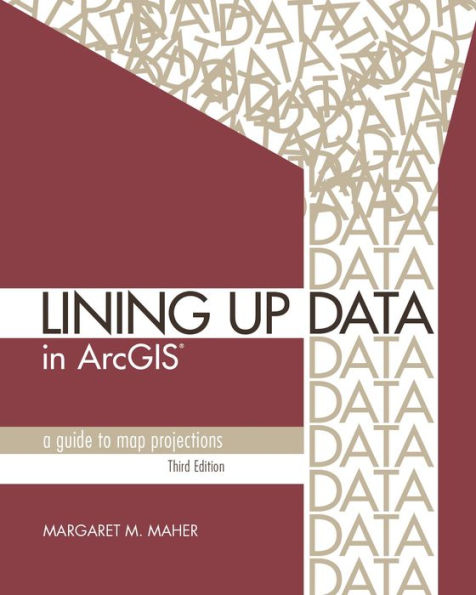

eBookThird Edition (Third Edition)
Related collections and offers
Overview
Lining Up Data in ArcGIS: A Guide to Map Projections is an easy-to-navigate, troubleshooting reference for any GIS user with the common problem of data misalignment. Completely updated with full-color maps and diagrams from ArcGIS Desktop 10.6 but still compatible with ArcGIS Desktop 10.1 and higher, this book presents practical techniques for identifying data projections and creating custom projections to align data. Formatted for practical use, each chapter can stand alone to address specific issues related to working with coordinate systems. With an added chapter on vertical coordinate systems, plus a newly available data download, the third edition of Lining Up Data will benefit new and experienced users alike.

Product Details
| ISBN-13: | 9781589485235 |
|---|---|
| Publisher: | Esri Press |
| Publication date: | 06/11/2018 |
| Sold by: | Barnes & Noble |
| Format: | eBook |
| Pages: | 250 |
| File size: | 16 MB |
| Note: | This product may take a few minutes to download. |
About the Author
Margaret M. Maher is an 18-year member of the Esri Support Services team. She has helped resolve more than 16,000 cases involving problems with map projections and data conversions. She has written numerous articles about ArcGIS Desktop for the Esri Support Knowledge Base.
Table of Contents
Preface
Introduction
Chapter 1 Identifying the Type of Coordinate System for Data Using ArcMap
Features in vector datasets
Using project on the fly in ArcMap
Identify the type of coordinate system for unknown data using ArcMap
Some common error messages and warnings
Examine the extent of the data
Geographic coordinate system extents
Identify the correct GCS for the data
Projected coordinate system extents
Commonly used projected coordinate systems
Local coordinate system extents and CAD
Summary
Chapter 2 Identifying the Correct Geographic Coordinate System
Example of datum offset between NAD 1927 and NAD 1983 datums in a GCS
Example where unknown data is in a GCS, and reference data is in a projected coordinate system
Other issues to consider
Define projection errors and warnings
Notes on transforming between the NAD 1983 and WGS 1984 datums
Summary
Chapter 3 Identifying the Projected Coordinate System
State plane coordinate system
Original zones in the state plane coordinate system
FIPS zones in the state plane coordinate system
Datums used with the state plane coordinate system
Universal transverse mercator (UTM) coordinate system
Extent limits of UTM
Datums used with the UTM coordinate system
Testing to identify the projected coordinate system for data
Apply state plane coordinate system options to the ArcMap data frame
Define the coordinate system for the unknown data as state plane
If state plane options do not align the data, test for UTM
Other projected coordinate system options
County coordinate systems
Statewide projected coordinate systems
Continental coordinate system options
Summary
Chapter 4 When Standard Coordinate Systems Don’t Work – Working with Non-Standard Units
Customizing the UTM coordinate system with units of feet
Datum offset between NAD 1927 to NAD 1983 in UTM
Customizing the state plane coordinate system with units of inches
Units of international feet vs. U. S. survey feet
Saving the custom projection file to disk for future use
Define the projection using the custom projection file
Summary
Chapter 5 Aligning CAD Data in ArcMap – Modifying a Standard Coordinate System
Issues to consider when working with CAD files in ArcMap
Procedures to address issues outlined above
1. Identify units of measure
2. CAD files created with references attached
3. If CAD data is in non-rotated local coordinates
4. Rotated CAD files
5. To improve layer/level visibility
6. If CAD files were created in ground coordinates
7. No spaces allowed in the projection file string
The scale factor may be applied to the false easting and false northing
If the data lies below sea level
Save the custom projection file to disk
Apply the custom coordinate system to the CAD file
Summary
Chapter 6 Aligning CAD Data in ArcMap–Lining up Rotated CAD Files
Adjusting for the azimuth or rotation parameters
To compensate for the rotation
To create the custom coordinate system
Select a geographic coordinate system
Start measuring
Modify the azimuth value
Other custom coordinate system options
Rectified skew orthomorphic natural origin
Summary
Chapter 7 Why Do We Need Geographic (Datum) Transformations?
What are geographic transformations?
Source of geographic transformation parameters in ArcGIS Desktop
Geographic transformation methods
Three parameter transformation methods
Seven parameter transformation methods
What difference does the transformation method make?
What difference does the direction of the transformation make?
NADCON and HARN transformation methods
NTv2 transformations
Molodensky-Badekas transformation
Longitude rotation method
Create and save a custom geographic transformation in ArcToolbox
Summary
Chapter 8 Applying Geographic Transformations in ArcMap and the Project Tool in ArcToolbox
Applying geographic transformations in the ArcMap data frame
Changing the coordinate system of the ArcMap data frame
Applying geographic transformations in the project tool in ArcToolbox
Summary
Chapter 9 What Map Projection Should I Use for My Project?
Geographic coordinate systems
Length of a degree on the ground
Projected coordinate systems
Linear units of measure
Properties of projected coordinate systems
Conformal
Equal area
Equidistant
True direction
How to decide on the projection to use for your project
Create the custom projection file in ArcMap
Accurate length measurements
What are false Easting and false Northing?
Summary
Chapter 10 Projection Files and Parameters; Adding XY Data; the shape of Buffers
Projection files installed with ArcGIS Desktop
Coordinate system parameters
What is a geographic coordinate system (GCS)?
What is a spheroid?
What is a datum?
What is a prime meridian?
What is a projected coordinate system (PCS)?
Why use a projected coordinate system instead of geographic?
Properties of projected coordinate systems
What is a local coordinate system?
Add XY data to ArcMap and convert to features in a shapefile or feature class
Adding the XY data table to ArcMap
Converting the XY data to shapefile or geodatabase feature class
Why buffers displayed in ArcMap are not round
Summary
